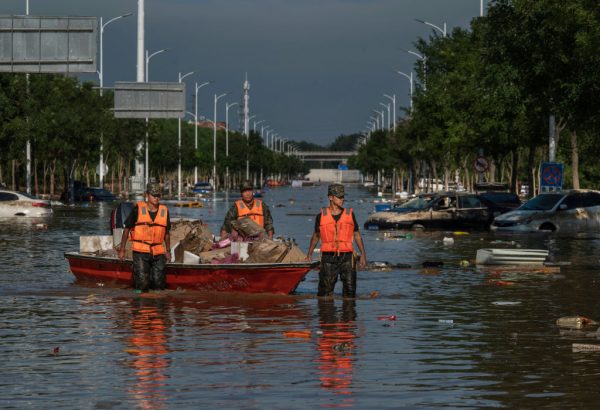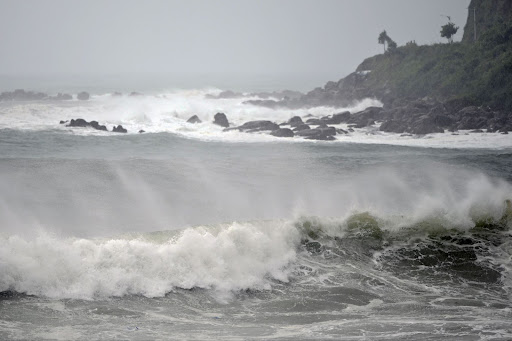Typhoon Khanun, the sixth typhoon to hit Asia this year, has once again changed its course, making a sharp 90-degree turn. It is expected to pass over the Korean Peninsula and enter Northeast China, with the potential for heavy torrential rains.
Meteorological authorities have issued warnings of flooding and high winds, which are reaching speeds in excess of 120 kilometers per hour (75 mph), while the general public braces for the storm.
So far, Typhoon Khanun has lasted nearly two weeks, far longer than the typical lifespan of a typhoon, which is about six to seven days.
In the afternoon of Aug. 7, the China Meteorological Administration (CMA) noted in its forecast that Typhoon Khanun made a sudden 90-degree turn to the north. The typhoon had originated in the Pacific several hundred miles east of the Philippines and took a course heading past the northern coast of Taiwan towards the eastern Chinese coastline.

But around Aug. 3 or Aug. 4, Khanun abruptly changed course, looping to the northeast in the direction of southwestern Japan.
Success
You are now signed up for our newsletter
Success
Check your email to complete sign up
Over the next few days, the CMA forecasts the center of the typhoon to make landfall on the southern coast of Korea and proceed northward across the entire Korean peninsula.
Starting Aug. 11 or Aug. 12, Khanun is expected to enter Northeast China, crossing the Sino-Korean border in China’s Liaoning Province. By then, the storm will have subsided to the level of a “tropical storm,” authorities predict.
Typhoon Khanun, which is named for the Thai word meaning “jackfruit,” began on July 28, and has resulted in the deaths of at least two people, both in the Japanese island region of Okinawa.
“An elderly woman in Okinawa died when her house apparently caught fire because she was using candles since the power had failed, NHK public television said. The other fatality was a man in his 90s crushed when a garage collapsed,” Reuters reported.
Concerns arise
As Khanun approaches, South Korea plans to evacuate 36,000 scouts from a coastal jamboree site in Buan by deploying over 1,000 vehicles starting on Aug. 8, officials confirmed.
The scouts, hailing from 158 countries, will be relocated to Seoul and surrounding areas, with arrangements being made at government centers, educational facilities, and hotels, South Korean authorities said. The evacuation from the campsite, which will not host any further events, is expected to take over six hours.
Meanwhile, in northeastern China, the typhoon has already started to produce significant rain.
Chinese netizens have expressed worry about the oncoming weather event, which comes concurrently with Typhoon Doksuri, the storm that bypassed Taiwan and ravaged China last week.
- Major Floods Strike Northern China, Killing 20 and Causing Widespread Destruction
- Tropical Storm Doksuri to Evolve Into a Super Typhoon, Threatens Taiwan, Hong Kong and the Chinese Mainland
- Typhoon Talim Sideswipes Hong Kong, Slams Into Southern China
One comment lamented that even without the coming onslaught, farmers in Northeast China were already struggling to maintain their crops. “It’s hard to imagine what will happen if this typhoon hits.”
The three provinces of Northeast China, home to around 100 million people, contains extremely fertile land and is an important breadbasket for the whole country.

“The Northeast can’t take it anymore,” another user wrote, describing the situation in Mudanjiang, a city located a few hours’ drive from the Russian border.
Northeast China had also been hit hard by Typhoon Doksuri, which made landfall near Fujian Province on July 27. Doksuri dumped record-breaking rains in Beijing and its surrounding areas, causing severe floods and destruction of property.
“So many houses were still inundated. The rice paddies were flooded, and the corn stalks were all knocked down,” the netizen continued.
Other comments echoed the concerns about the impact on Northeast China’ farmers, while others urged people to prepare emergency supplies of food, water, and other essentials.
Up to 200 millimeters (8 inches) of rain are expected in some parts of the region, mostly in the south and east, as Khanun enters Northeast China. Local meteorological authorities are warning the public to be prepared for various emergency events.
Leo Timm and Todd Crawford contributed to this report.
















